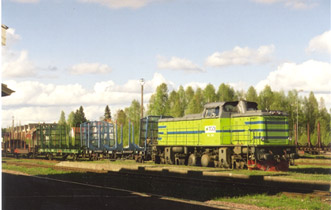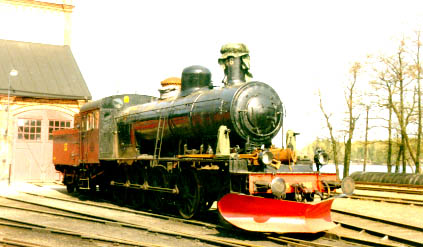
A TGOJ T43 resting for the weekend in Orsa, August 2001. See more in Ollies trainstuff!, all colorphotos by Ollie Ahokas
This feature is somewhat different, compared with the other sites I have discussed earlier. First I discuss a line that is too long to model completely by anyone, but never the less you could settle for a small portion of the of this interesting line, built for the brighter future for the citizens of the in lands of Sweden.
Modelling ideas.
Scenery

There might raise a question how be able to model a complete line of this length, as there is pretty unlikely to find a building large house the layout. But secret is to model portions of the line or highlights or just one station. Today, most of the line is rationalized, so most of the maintenance prone turnouts not used are removed. This means that most of the stations are more or less haunted house or turned in to private housings in isolated villages.. Never the less, it is a very interested line to model wheter in the past with steam and railcars or as it appears today.
This means that the layout is best suited as linear design on on rather generous wide shelves. By placing the shelve close to the eye level and you can use smaller scale models on the background to add depth, to visualize the vastness of the area. This is a moose area so a few mooses here a nd there in the forrests add intrest and a popular area for salmon and trout fishing.
To create scenery along the line you much enjoy, scenery specially rolling mountainous scenery and a lot of trees, intersected by swamps, and streams and twisting rivers with small waterfalls and rapids. The mountains along the line are rolling and treecovered. Here and there small villages of typical swedish wooden houses. The vast majority are painted in brownish red with white trim. Maybe a small farm or two of which at least one of them is abandoned, forgotten by progress of our time. The oldest farm buildings are of timbered construction, and orginally they were varnished, but the time has turned their color in variation of greys and black. You could break up maybe of adding a sawmill, today they have increased insize, Walthers sawmill is very close, specially if you combine it with a variation of Pikesize modern warehouses. You could add quarry and crushing plant for limestone. Offline industries would be power station and dam built over waterfalls.
For the railroad buildings there is a chanche you cn model them pretty easily. Pola produced a typical swedish station called Diö, but the stations north of Sweg and south of Mora (on the abandoned part) are pretty close, you just add on Heljans small freight station no. 1760 to it, unless you want to create an exact model. By the way Model Power still offers it as Chester Station No.454.

A new type of engines were constructed for the Inlandline type E, many of these 0-8-0 engines were later rebuilt to 2-8-0.s and classified as E2, like this preserved engine in Nora.
Modelling ideas.
The consists
The area is isolated so the trains on the lines were in the beginning very varied. You could use anything, except the finest of expresstrains. Mostly of the passenger runs which were using steam was rather varied, with cars usually sleepers connected to the elderly equipment of the troughtrains, but the most common was a rather shortconsists of an engine a bagggage car, acouple of elderly open platform cars in 4-wheeled and 8-wheeled types followed with a couple of boxcars for expressfreights, like milk from the local farmers to the xxx. these trains used whatever power like the L-class Moguls, E or E2.s or a tankengine. The pace of these trains was leisure, with frequent stops to load and unload mail, passengers and express freight. Sometimes, specially, during skiing season occational long consists hauled vacationeers to the resorts, using what ever cars available SJ even constructed temporary bunks by cleverly using boards.
Freights were also a kind of extended peddlers, varing in length carring supplies to the communties along the line. The biggest source of revenue was timber, and during the winter the timber was cut and stacked along the line, using the the snow and the frost as firm surface. durnig the thaw of the spring the timber were transfered to stake cars for further tansportation to the sawmils and the paper plants near the eastern coast. There were a cheaper way to transport the timber, using the rivers where possible. The labour was cheap and available for this dangerous work. But after the WWII, using rivers as the transportation declined, much because the paper mills increased in size and requireing a steady around the year supplies of timber. Early spring spring remained as a busy season. during the fifties the highroads dryed out the freight on the peddlers and the steam started to be replaced by steam.
First victims were the passenger runs, replaced by the sleek DMU.s of Y6-8 classes and during the sixities SJ rostered enough of dieselpower to replace the steam. The highway traffic increased, much of the modernizations and heavier trucks increased in number. In the early nineties the freights were infrequent and slow, much because of decreased maintenance. But the interest of alternative energies since after oilcrises of 1973 increased and during the last years as part of the national system the first unittrains of from Sweg to Uppsala started to roll over the southern part. In a few years thes increased in length from a hand ful of rented Fals-cars from Germany and Holland to the 3 containers on 24 flatcars today. The powe for these trains wer usually a pair some times three units of T44-class units. SJ used flatcars of older designs, loading only two containers, over each truck, but IBAB/Inlandgods leases or owns cars of larger capasity,using the entire 60 ft dcek for containers. In the early days of IBAB/Inlandgods operation, some other loads could ocationally found on these trains but appearently lost this traffic to SJ and to the highway trucks. The curent power for this train is two units of one TMX and TMY. But these aging power needs looked after, so it is not unusual to find the train hauled by T43.s or in lashup with a TMX/TMY, The occational trainloads of timber is hauled usually by a single leased T43.